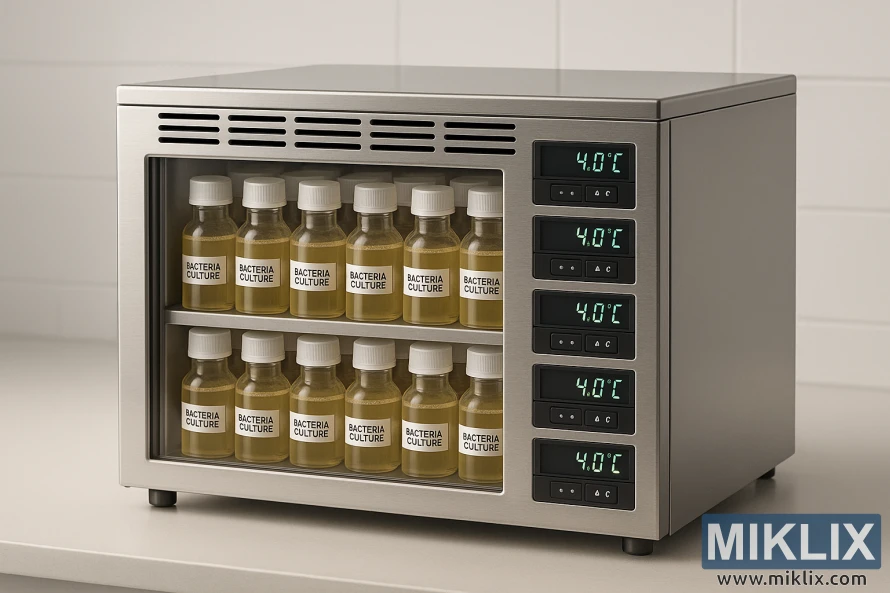Image: Bacterial Culture Storage Unit
Published: September 15, 2025 at 7:14:16 PM UTC
A sleek stainless steel lab storage unit with glass door showcasing neatly organized vials of bacterial cultures cooled to 4°C.
The image shows a meticulously arranged, high-quality storage unit designed specifically for housing bacterial cultures used in sour beer fermentation. It sits on a pristine, pale-toned laboratory countertop, framed by a backdrop of clean, white-tiled walls. The overall composition radiates order, precision, and professionalism, presenting an environment where scientific care and brewing artistry intersect.
The storage unit itself is compact yet robust, with a rectangular form crafted from sleek brushed stainless steel. Its design is modern and minimalist, with sharp, clean edges and a seamless finish that reflects the soft, diffused laboratory lighting. This subtle reflection lends the metal surfaces a gentle sheen without producing glare, emphasizing the unit’s polished, hygienic appearance. The front face of the unit is dominated by a large tempered glass door panel that offers a clear view of its contents while maintaining an air of controlled containment. The glass is perfectly transparent, catching only the faintest glimmers of reflected light along its beveled edges, and it is flawlessly clean, reinforcing the sense of sterility.
Inside the unit, two evenly spaced horizontal shelves hold neatly aligned rows of identical small glass bottles. Each bottle is cylindrical with straight sides and topped by a white screw cap. They are filled to about two-thirds of their volume with a pale yellow liquid—the bacterial cultures essential to sour beer fermentation. The liquid appears consistent across all bottles, and its slightly viscous clarity is accentuated by the bright internal illumination of the storage chamber. Each bottle bears a clean white label marked in crisp black text: “BACTERIA CULTURE.” The labels are perfectly aligned and uniformly applied, underscoring the meticulous care and systematic organization typical of laboratory protocols.
Running vertically along the right-hand side of the unit’s front is a sleek control panel featuring six identical digital display modules, each corresponding to one of the internal compartments or zones. Each module has a small rectangular green LED screen displaying “4.0°C” in precise, glowing numerals, indicating the temperature is being held at a cool and stable level optimal for preserving microbial cultures. Beneath each temperature readout are a pair of small, clearly labeled adjustment buttons marked with triangular icons, showing that the temperature can be finely controlled as needed. The consistent readouts and identical arrangement of the controls add to the impression of reliability, uniformity, and technological refinement.
The soft, indirect lighting that fills the room enhances the aesthetic impression of clinical cleanliness. There are no harsh shadows; instead, light gently wraps around the contours of the unit and reflects subtly off the smooth surfaces of both the stainless steel casing and the glass door. This creates an evenly lit scene that conveys calmness and control, removing any sense of clutter or chaos. The background is intentionally minimal, with the white tiled wall slightly out of focus, ensuring all visual attention stays on the storage unit and its contents.
The camera is angled slightly from above and to the left, providing a clear view not just of the front face but also of the top and right side of the unit. This elevated perspective emphasizes the compact efficiency of the design—showing that the unit can hold a substantial number of samples while occupying minimal space on a laboratory bench. The image composition as a whole reinforces the mood of precision and conscientious stewardship: this is not a chaotic workspace but a carefully controlled environment where microbial cultures critical to the development of complex sour beer flavors are handled with the highest degree of scientific rigor.
Overall, the photograph portrays an idealized fusion of science and craft: a temperature-controlled, glass-fronted stainless steel storage unit, glowing softly in a spotless laboratory, safeguarding rows of labeled bacterial culture vials. It embodies the meticulous care, attention to detail, and respect for process that underpin the art of sour beer fermentation.
The image is related to: Fermenting Beer with Fermentis SafSour LP 652 Bacteria

